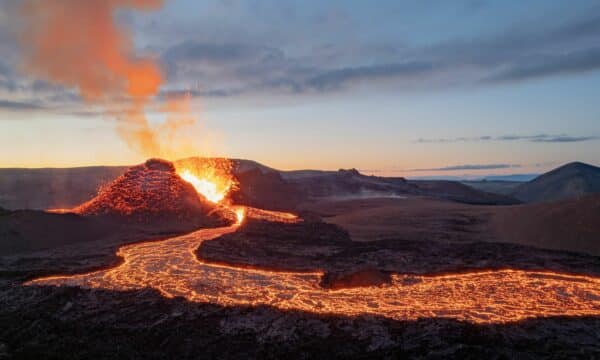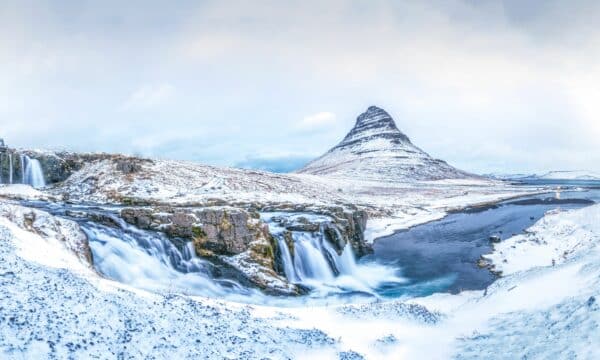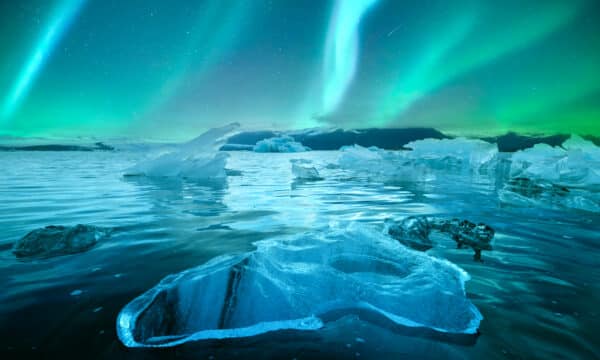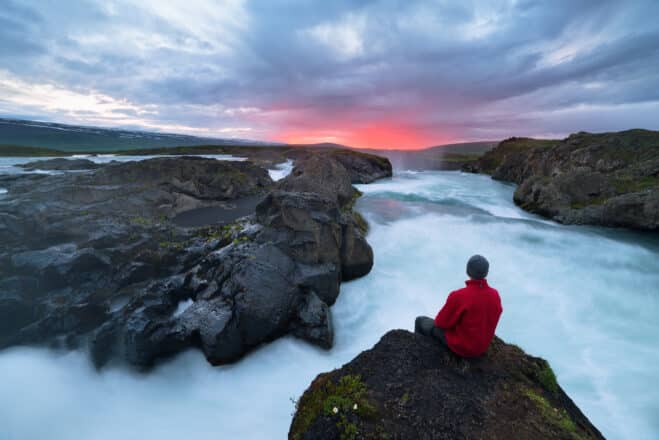
The most pressing question when solidifying travel plans is: what is the best time of year to visit Iceland?
Conventionally, the best time to visit Iceland is in the Midnight Sun-kissed summertime. Not only do June to August offer the most accommodating weather conditions, but the neverending daylight hours also promise maximum access and flexibility to most attractions across the country.
Roads that are inaccessible or closed in the wintertime are open, and more remote locations and trails are unfettered by pesky ice or snow, which is characteristic of the winter months. Puffins only nest in Iceland during the summer, and your chances of seeing the greatest number and variety of whales increase this season.
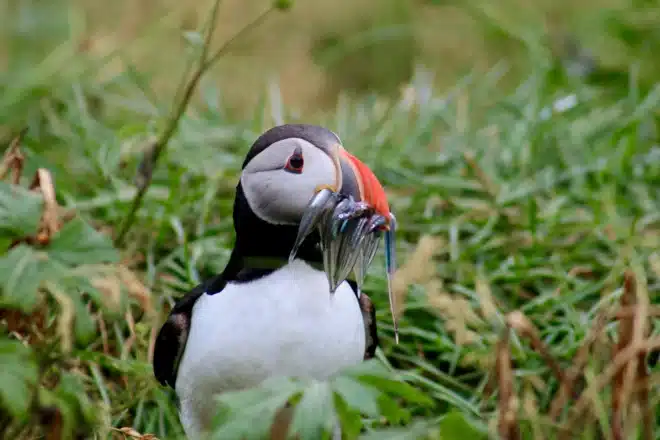
That said, Iceland is undoubtedly an all-year-round destination. Some of the most sought-after attractions, such as the Nothern Lights, are only accessible in the winter. Many of the most popular sightseeing tours, such as the Golden Circle and the South Coast, run throughout the year and are equally breathtaking, whatever the month or weather.
Wintertime is cosy and spellbindingly beautiful, offering the quintessential snowy tableaus and icy sculptures that spring to the imagination when one thinks of Iceland. The contrast of the dazzling white frozen landscapes set against the moody darkness of winter is no less captivating than the heady sun-filled days of the summer months.
Christmas and New Year offer a unique atmosphere to experience the natural beauty of Iceland and add a rich cultural flavour to your absorption of all things Icelandic. Decorations, festive food, and, not least, massive fireworks displays all carry their own allure that might tempt you to visit Iceland during yuletide.
So When is the Best Time to Visit Iceland?
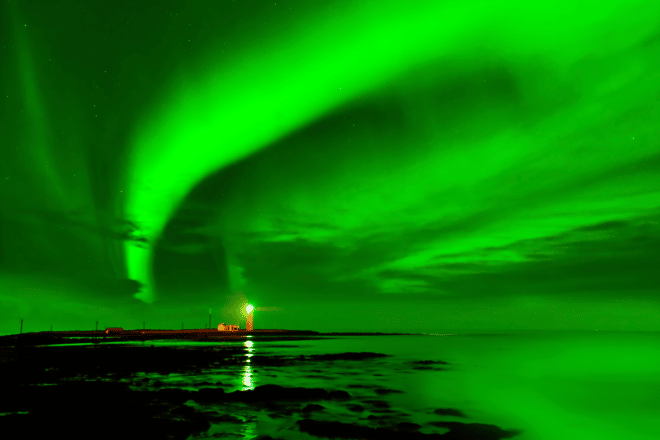
The best time of year to visit Iceland depends on what you want to see while you’re here. As someone who’s lived and travelled around Iceland every month, I can testify that there’s never a bad time to visit!
Below is a guide that will run through all your options and their seasonal availability to help you decide the best time for you to visit Iceland. You can also click here to get a free custom itinerary proposal from Traveo.
But for my insider tip? The truly best time to visit Iceland doesn’t necessarily correspond to a time of year or a particular attraction but rather when you have enough time. There’s so much to see here, and it’s perfect to have at least a week to get out of the city and travel to the more far-flung and breathtaking views Iceland has to offer. So the best time to book is NOW!
Best Time to Go to Iceland Weather-Wise
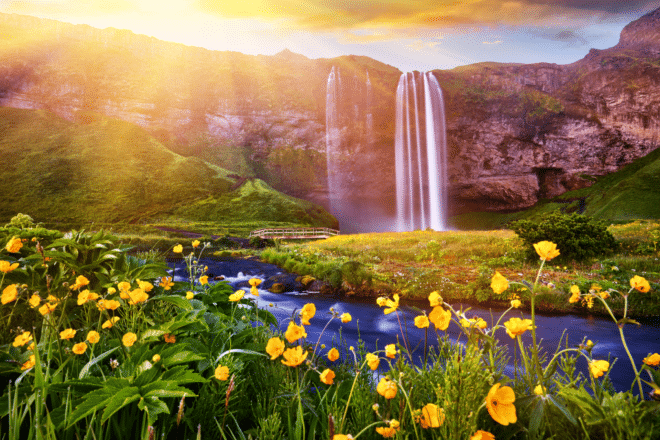
The best time to visit Iceland weather-wise is during the warmest months, from June to August. The average temperature during these months ranges from 10-13°C (50-55°F). And the days are long, with almost 24 hours of sunshine during the summer solstice.
The coldest months are from December to February, with an average temperature of -1 to 2°C (30-35°F). The driest months are from May to July, with the least rainfall.
Overall, if you want to experience Iceland’s warm weather and avoid the cold and wet months, the best time to visit is during the summer months.
Best Time to See the Midnight Sun in Iceland
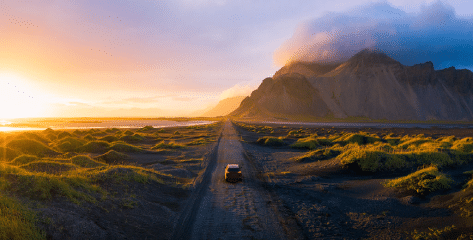
The best time to see the Midnight Sun coincides with peak season in Iceland, between June and July, with 20-21 hours of sunshine. Just remember to bring an eye mask so you can sleep at night.
The main benefit of visiting during this time is, of course, the weather and the extended daylight hours. So not only are more routes and trails safe and accessible, but you also have more time to see them.
As with peak seasons anywhere, the downside is everyone’s got the same idea, which means higher rates and more avid travellers jostling for access and photo opportunities (and parking spaces!).
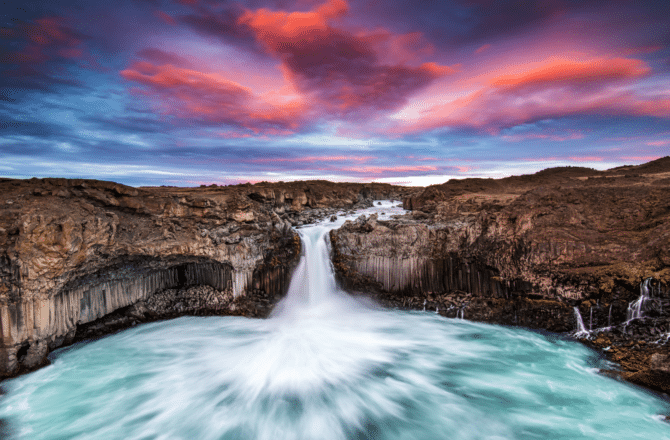
Pro tip: If you want to enjoy the fairer weather conditions and the Midnight Sun, hire a car and visit attractions later in the day, at night, or even in the small hours of the morning. One of my favourite experiences of driving around Iceland was when we did exactly that, arriving at some destinations as late as midnight.
There’s something indescribably special about having a colossal waterfall all to yourself in the still and eerie twilight of the Midnight Sun.
If you have booked accommodation, it’s worth checking in first before commencing on your alternative hours’ itineraries. And if you are camping, it is possible to arrive at night and catch up with the fees at the office or with an attendant in the morning.
It’s also worth saying that although June-August is often considered peak time, you’ll find that the less busy month of May boasts a considerable 17 hours of daylight (similar to August). However, temperatures will be a little cooler.
Best Time to Visit Iceland to See the Northern Lights
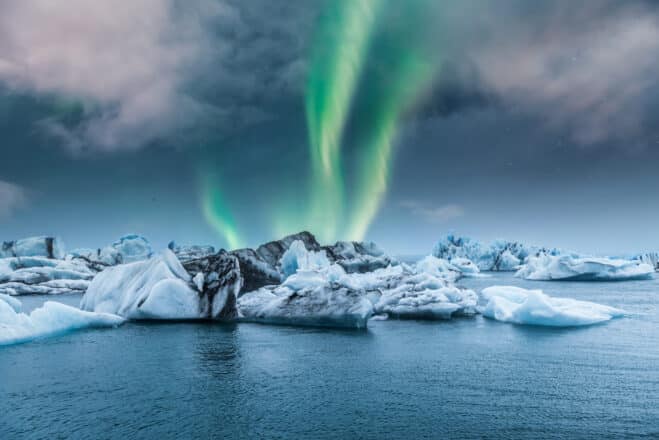
Your best chances of seeing the Northern Lights are generally between October and March. That said, I have seen them as early as August and as late as April, even in Reykjavík’s city centre.
The likelihood of spotting the ethereal aurora depends on levels of solar radiation (measured by the Kp index), cloud cover and darkness.
Fun fact: the aurora borealis still occur in the summer, but they are impossible to see due to the neverending daylight hours.
You can check the aurora forecast and weather conditions on the National Icelandic weather website here. If the forecast looks promising, it’s a good idea to get into the countryside, away from any light pollution, for a more vivid display and better photos. To optimise your pictures, bring a tripod for those impressive long-exposure snaps.

Booking a tour is a great option as your guide will know the forecast and the most befitting locations to gaze at this epic astronomical phenomenon. If you book a tour but the forecast doesn’t look good, many providers will offer you a place the following evening or the next!
It’s a little bit tricky when planning in advance as you never know how conditions will be so far into the future. However, a flexible and positive attitude matters most when travelling to Iceland for the Northern Lights.
Iceland has so much to offer in the wintertime, so plan a fully packed journey so that upon seeing the dazzling aurora, it will be an added bonus to your trip. And if you don’t see them, you’ll still come away with a bucket full of magical memories. Not to mention a reason to come back!
Best Time to Go Whale Watching
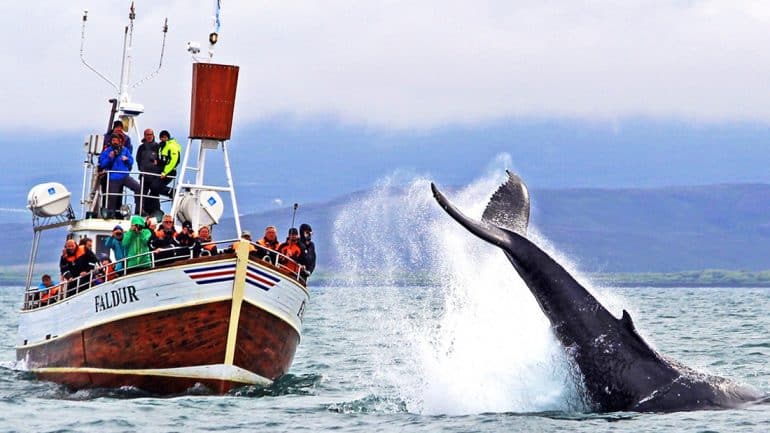
Whales and other cetacean species are most abundant in the waters surrounding Iceland from April to September. Therefore, June, July and August are the peak season for whale watching.
During this season, you’re very likely to spot whales and, often, more than one species, including minke, humpback, harbour porpoises and sometimes even the enigmatic orca or blue whale. The quaint fishing town of Húsavík in the north of Iceland is often touted as the best place to spot whales, with some companies advertising unbroken records of whales spotted every excursion.
Many whales migrate south in the winter months for warmer waters, but luckily, not all of them, which means whale-watching tours are available all year round. Having worked in the tourism industry here in Iceland for a long time, I’ve been on my fair share of whale-watching excursions. And I’ve never been disappointed, summer or winter, rain or shine.
Best Time to See Puffins in Iceland
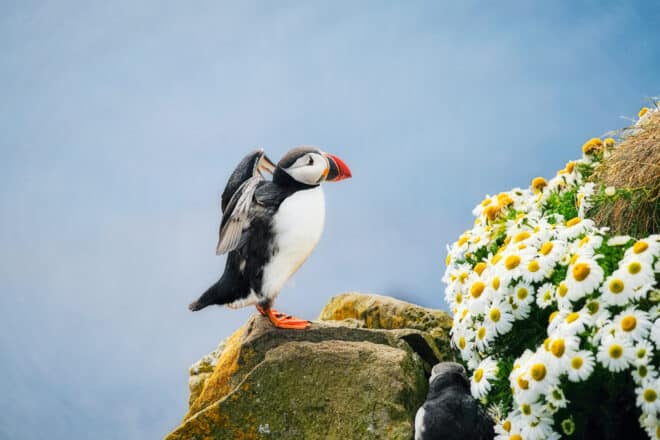
The Atlantic puffin is a special and much-beloved bird species. People worldwide relate to their vibrant colouring and expressive, almost human-like adorable faces with their little eyebrows and perfectly rotund shape. However, unlike other birds, their bones aren’t hollow; they flap their wings over 400 times a minute, giving the illusion they shouldn’t really be flying at all…
OK, I’ll stop. But let’s be agreed, puffins are fabulous birds, and here in Iceland, we are fortunate that more than 60% of the world’s entire Atlantic puffin population flock to our shores to nest every year from mid-April to August. That’s approximately 8-10 million of those suited cuties every year.
They nest in cliff faces, and it’s possible to get close and observe their highly social behaviour and characterful chirrups and warbles. Just be careful on cliff ledges as their burrowing can make the ground unstable, so always keep a safe distance.
The Westfjords, the South Coast near Dyrhólay and the Westman Islands are great places to see puffins. We love puffins so much we’ve got a whole article on them. Check it out, here!
Best Time to Hiking in the Highlands
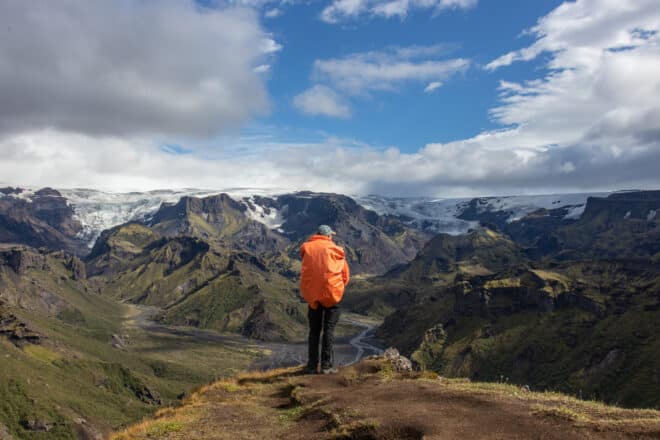
For those looking to explore the country’s wild interior on foot, the summer offers exclusive access to Iceland’s rugged Highlands. You won’t need to worry about beating the crowds here as it is the least explored region for tourists.
Generally speaking, roads to the Highlands are open from June to early September, but sometimes weather conditions can delay or extend road closure. You can check their status here. July and August would be your safest bet and are definitively the best time for a hiking trip in the famed Landmannalaugar Region or the Þórsmörk Valley.
You can book a tour or hire your own 4WD but be sure to thoroughly research your route, as it might require fording rivers or particularly challenging driving conditions.
Best Time to Vist the Westfjords
Much like the Highlands, the best time to visit the Wesfjords is between June and August. Although not as wild and far more accessible than the Highlands, the Westfjords is interconnected by many gravel roads and white-knuckle passes.
Unlike the Highlands, though, you are not required by law to drive a 4WD for most of the main roads, and you won’t have to ford any rivers – unless you’ve gone terribly wrong somewhere.
Although I would say the peak summer months are the best time to visit, the Westfjords are far more hospitable than the country’s interior. I’ve driven there myself in a (very old) city car during May and September, and I’m still here to tell the tale. It’s one of my absolute favourite parts of the country. And it has far fewer tourists! So drive carefully and enjoy!
Best Time of Year to Visit Iceland’s Blue Lagoon
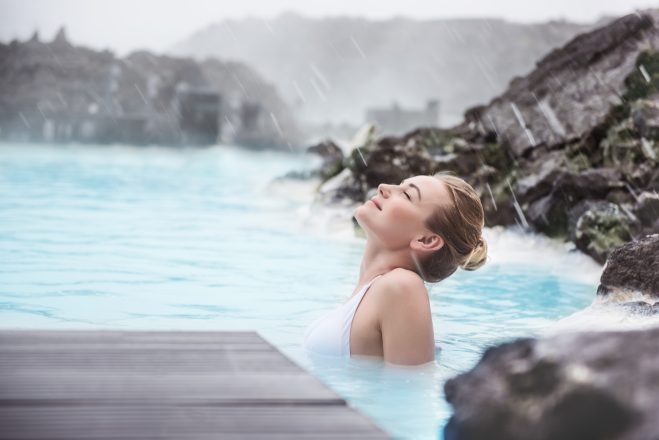
Always! The Blue Lagoon, Sky Lagoon and all other hot springs and geothermal pools are always blissfully gorgeous, no matter the season or the weather. Of course, some times of the day can be busier than others. However, booking a slot or arriving earlier in the day will ensure more uninterrupted tranquillity.
Best Time to Visit the Diamond Beach in Iceland
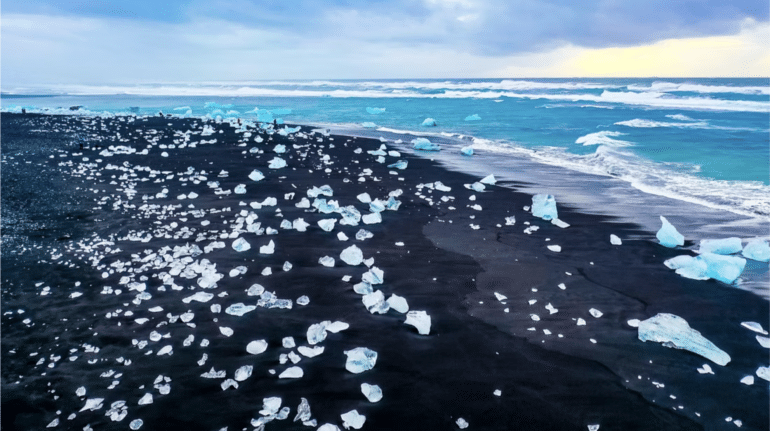
If you have Diamond Beach in Iceland on your bucket list, you’ll be pleased to know that there is no bad time to visit. While summer days may be more comfortable for some travellers, the colder months create a unique and magical scene. A visit to Diamond Beach and the nearby Jökulsárlón Glacier Lagoon will surely make for an unforgettable trip, regardless of the season.
Best Time to Visit Ice Caves in Iceland

If you’re planning a trip to Iceland, you don’t want to miss out on visiting the beautiful ice caves. Knowing the best time to visit these natural wonders is important to ensure they’re open and accessible during your trip.
The Katla ice cave is open year-round, so you can visit anytime you like. However, if you want to explore the ice caves in the Vatnajökull Glacier, you’ll need to plan your trip between October and April, as these caves are only open during this time of year.
Best Time to Visit Iceland for Festivals and Cultural Events

If you’re planning to visit Iceland, you might want to consider timing your trip around some of the country’s exciting festivals and events. For music festival lovers, the most famous one is Iceland Airwaves, which takes place during the dark nights of November. But if you’re looking for something a little more off the beaten path, check out Aldrei fór ég suður. This festival is held annually at Easter in the Westfjords and is just as good as Iceland Airwaves.
Film buffs might want to check out Reykjavík International Film Festival, held in September and October, or the scary Frostbiter Icelandic Horror Film Festival, held in the little town of Akranes in January each year.
Other fun events include the Icelandic National Day on June 17th, Reykjavik Fringe Festival in July, the Pride Festival and Culture Night in August, and the Winter Lights Festival in January/February.
Christmas in Iceland
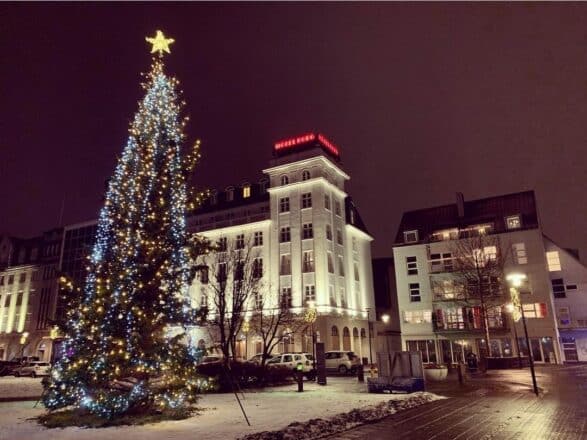
Speaking of festivals…
In my opinion, one of the best times to visit Iceland is during the holiday season, from late November to the first week of January. Icelanders are crazy about yuletide celebrations, and a rich culture surrounds this special time of year.
We go all out on covering anything we can in twinkling fairy lights to brighten the seasonal darkness, rendering the already winter wonderland sceneries all the more romantic.
As well as rich folklore and traditions, there’s also a host of extra delicious foodstuffs available at Christmas. Not to mention, spotting the Northern Lights at this time is likely.
We actually have an entire article dedicated to Why you need to visit Iceland at Christmas Time, so go check it out!
New Year’s Eve in Reykjavík
Many people flock to the world’s most northern capital to ring in the New Year, and with good reason. If you want to see the most incredible fireworks display of your life, you should join them.
There is a publicly organised explosive show every year at the monumental Hallgrimskirkja church downtown. However, adding to that, everyone in the city sets alight to cases of fireworks en masse making for the most impressive incendiary spectacle that you’ll ever witness.
Icelanders party hard to celebrate New Year’s, so this is also the perfect time to witness the downtown Reykjavík nightlife and mingle with the jolly locals. This is a very popular time of year, so be sure to book accommodation and tours in advance, and if you’re planning on eating out, you’ll want to make reservations as early as possible.
Worst Time to Visit Iceland?
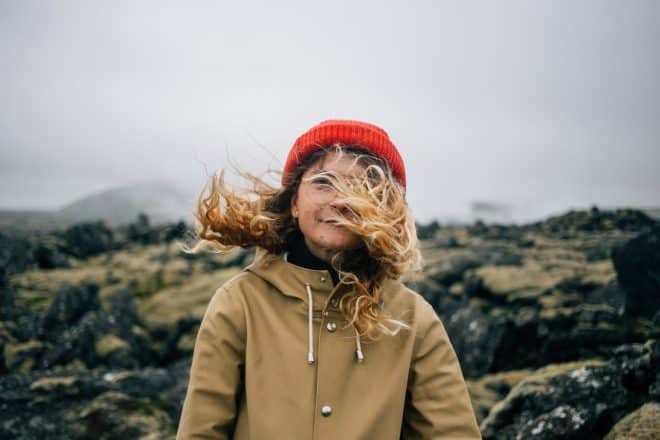
The worst time to visit Iceland could arguably be the second half of January once the Christmas decorations and festivities have blown over and into the first half of February. The cold and the darkness drags a little for the locals, and there is a high frequency of storms and inclement weather.
There are plenty of things to do in the case of bad winter weather, and there’s always still a possibility of seeing the Northern Lights as well as snow-covered scenic landscapes.
Iceland’s natural geothermal energy means it’s always warm indoors. And no matter the weather, the swimming pools are always warm. One of my favourite things to do in a storm is to sit in the hot pool at my local pool and feel the raw forces of nature.
Cheapest Time to Visit Iceland

If you’re planning a trip to Iceland, it’s important to consider the cost. The cheapest time to visit Iceland is during the shoulder seasons, which are the months of April to May and September to October. During these times, you can find more affordable prices for hotels, rental cars and some outdoor activities.
Another way to save money is by taking a road trip instead of relying on expensive tours. Instead, you can rent a car and explore the country at your own pace, which can be a more budget-friendly option. However, keep in mind that Iceland can be pretty expensive, even outside the peak tourist season, so remember to plan accordingly and budget wisely.
Conclusion
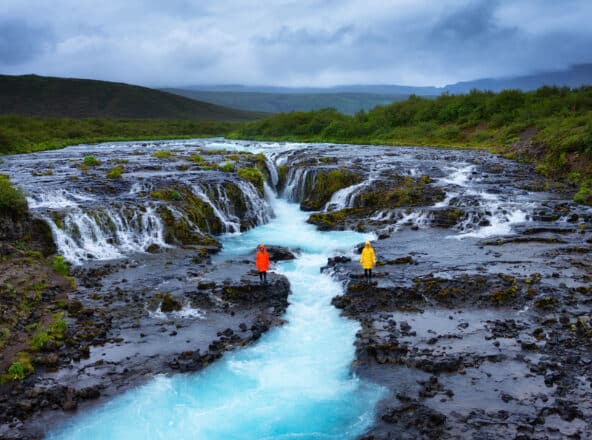
Iceland is a country that offers something for everyone, no matter what time of year you visit. So whether you’re a nature lover, an adventure seeker, or a cultural enthusiast, Iceland has something for you.
Traveo can help you find the best time to visit for your desired activities and plan your perfect trip to this land of fire and ice. Click here to get a free itinerary proposal.
So pack your bags, and get ready to explore Iceland’s stunning landscapes and unique culture.

